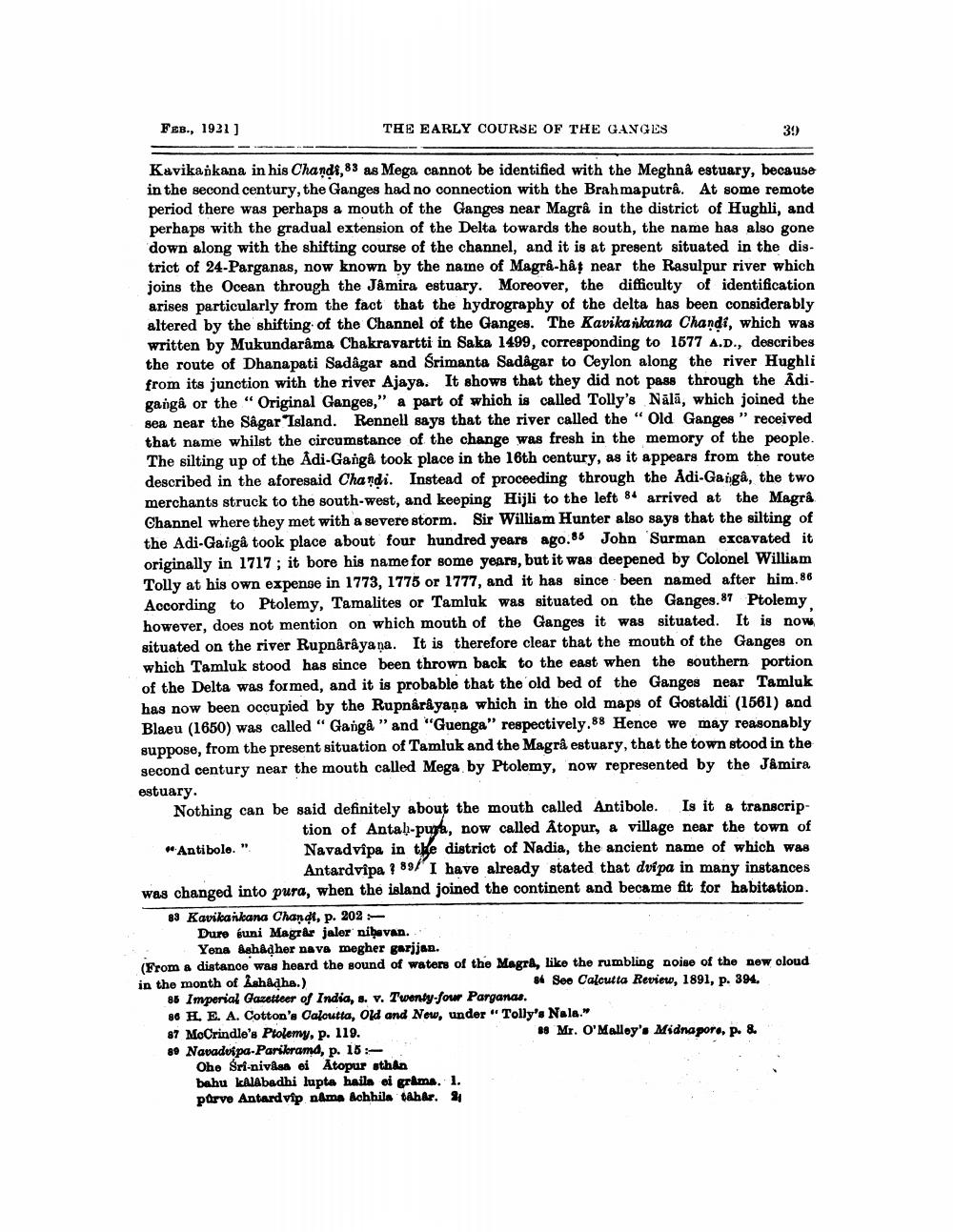________________
FEB., 1921]
THE EARLY COURSE OF THE GANGES
39
Kavikaokana in his Chandi, 83 as Mega cannot be identified with the Meghna estuary, because in the second century, the Ganges had no connection with the Brahmaputrâ. At some remote period there was perhaps a mouth of the Ganges near Magrâ in the district of Hughli, and perhaps with the gradual extension of the Delta towards the south, the name has also gone down along with the shifting course of the channel, and it is at present situated in the district of 24-Parganas, now known by the name of Magrå-hat near the Rasulpur river which joins the Ocean through the Jâmira estuary. Moreover, the difficulty of identification arises particularly from the fact that the hydrography of the delta has been considerably altered by the shifting of the Channel of the Ganges. The Kavikaikana Chandi, which was written by Mukundarâma Chakravartti in Saka 1499, corresponding to 1577 A.D., describes the route of Dhanapati Sadagar and Srimanta Sadâgar to Ceylon along the river Hughli from its junction with the river Ajaya. It shows that they did not pass through the Adigangå or the “Original Ganges," a part of which is called Tolly's Nālā, which joined the sea near the Sågar Island. Rennell says that the river called the “Old Ganges " received that name whilst the circumstance of the change was fresh in the memory of the people. The silting up of the Adi-Gangå took place in the 16th century, as it appears from the route described in the aforesaid Chandi. Instead of proceeding through the Adi-Ganga, the two merchants struck to the south-west, and keeping Hijli to the left 86 arrived at the Magrâ Channel where they met with a severe storm. Sir William Hunter also says that the silting of the Adi-Gaiga took place about four hundred years ago.85 John Surman excavated it originally in 1717 ; it bore his name for some years, but it was deepened by Colonel William Tolly at his own expense in 1773, 1775 or 1777, and it has since been named after him. 86 According to Ptolemy, Tamalites or Tamluk was situated on the Ganges. 87 Ptolemy. however, does not mention on which mouth of the Ganges it was situated. It is now situated on the river Rupnârâyana. It is therefore clear that the mouth of the Ganges on which Tamluk stood has since been thrown back to the east when the southern portion of the Delta was formed, and it is probable that the old bed of the Ganges near Tamluk has now been occupied by the Rupnârâyaņa which in the old maps of Gostaldi (1561) and Blaeu (1650) was called “Gangå" and "Guenga" respectively.88 Hence we may reasonably suppose, from the present situation of Tamluk and the Magra estuary, that the town stood in the second century near the mouth called Mega by Ptolemy, now represented by the Jâmira estuary. Nothing can be said definitely about the mouth called Antibole. Is it a transcrip
tion of Antah-puyla, now called Atopur, a village near the town of Antibole." Navadvipa in the district of Nadia, the ancient name of which was
Antardvipa ? 89/' I have already stated that dvi pa in many instances was changed into pura, when the island joined the continent and became fit for habitation 83 Kavikarkana Chandt, p. 202
Dure éuni Magrêr jaler nihavan.
Yona kehadher nava megher garijan. (From a distance was heard the sound of waters of the Magra, like the rumbling noise of the new cloud in the month of Ishadha.)
* Soo Calcutta Review, 1891, p. 394. 86 Imperial Gazetteer of India, s. v. Twenty-four Parganas. 80 H. E. A. Cotton's Caloutta, Old and Now, under "Tolly's Nala." 87 MoCrindle's Ptolemy, p. 119.
Mr. O'Malley's Midnaporo, p. & 89 Navadutpa-Parilramd, p. 15
Ohe Sri-nivisa si Atopur sthan bahu kalAbadhi lupta haila ei grama. 1. parve Antard vip nama Achhila tahlr. 24




